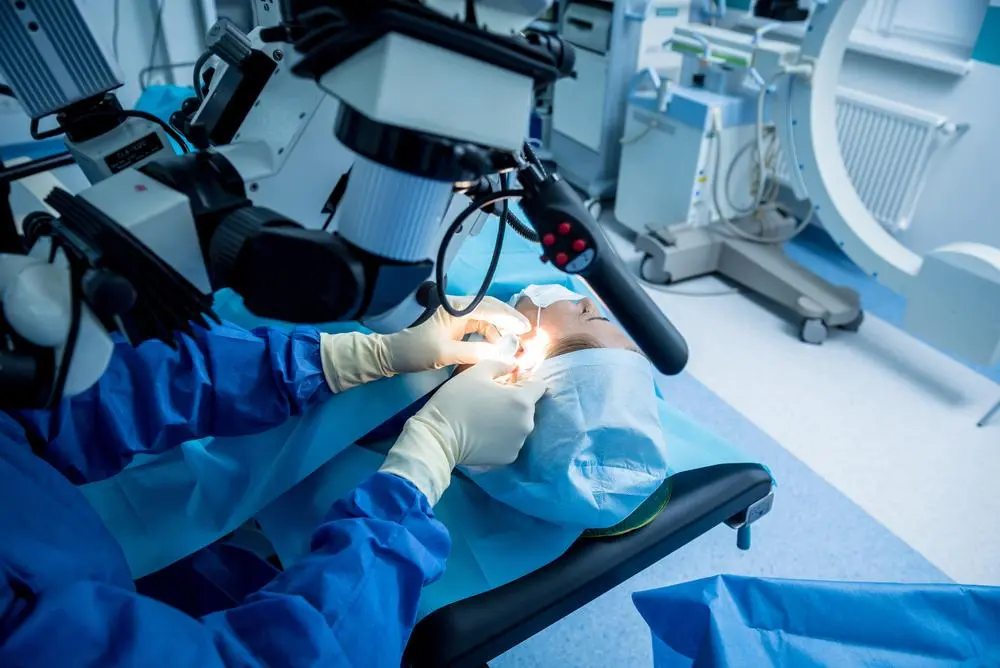Surgical Treatment for Otosclerosis in Dallas, Fort Worth, and Frisco, TX
Stapedectomy
The conductive-type of hearing loss of otosclerosis is correctable by a highly successful surgery known as a stapedectomy. The surgery can be performed in the operating room either under local anesthesia with intravenous sedatives or under general anesthesia. Stapedectomy is a very delicate procedure performed under high power magnification using an operating microscope made specifically for ear surgery. The operation is performed entirely through the ear canal. A tiny incision is usually made on the back of the ear for the purpose of obtaining a tissue graft. This incision is hidden behind your ear and not visible.
The operation consists of elevating the eardrum and inspecting the hearing bones directly. The immobile, fixed stapes bone is then removed and a hole is made in the footplate using a highly precise laser. Once the stapes is removed, the oval window is sealed with a tissue graft, and a tiny prosthetic stapes is put into position, connecting the other hearing bones (the malleus and incus) with the oval window. The eardrum is repositioned and absorbable sponge packing is placed into the ear canal.
After healing has occurred following surgery, sound waves travel down the ear canal and touch the eardrum which moves the new, mobile hearing bone mechanism and allows the patient to hear once again. The prosthetic stapes hearing bone that is placed vibrates as the eardrum moves with sound and causes the fluid of the inner ear to move and stimulate the tiny nerve cells that allow us to hear.
The surgical procedure is performed in the outpatient setting and patients go home later that same day. Since the inner ear contains the balance organs, dizziness rarely can occur. Nose blowing, heavy lifting, straining and flying are prohibited in the first few weeks following a stapedectomy.
Hearing improvement is typically noticed when the patient returns to the office to have the packing removed from the ear canal. Many patients note a significant improvement at this point that continues to improve for weeks and months after the surgery. It is not uncommon for patients to note that running the faucet sounds like they are hearing a waterfall. The brain sensitivity to the new sounds that the ear can now hear improves over time and it becomes the “new normal”. Stapedectomy is highly successful in 95% of patients.

What are the Risks of Otosclerosis Surgery?
Hearing loss
In approximately one percent (1%) of cases, hearing may be further impaired due to the development of scar tissue, infection, blood vessel spasm, irritation of the inner ear or a leak of inner ear fluid (fistula).
In less than one percent of cases, hearing may be damaged such that a complete hearing loss may occur and one may not be able to benefit from a hearing aid in that ear. Due to this theoretical risk, the poorer hearing ear is usually selected for surgery first.
When further loss of hearing occurs in the operated ear, ear ringing (tinnitus) may be more pronounced. Rarely, re-exploration may be necessary when hearing loss occurs, but time is usually given to allow the ear to heal completely.
Tinnitus
Most patients with Otosclerosis experience ear ringing (tinnitus). The amount of tinnitus is not necessarily related to the degree or type of hearing impairment. Following successful stapedectomy, tinnitus is often decreased in proportion to the hearing improvement, but occasionally it may worsen.
Dizziness
Dizziness may occur for a few hours following a stapedectomy and may result in nausea and vomiting. Some unsteadiness is common during the first few postoperative days. Dizziness with sudden head motion may persist for several weeks. On rare occasions, dizziness is prolonged.
Taste Disturbance and Mouth Dryness
Taste disturbance and mouth dryness are not uncommon for a few weeks following surgery. In five percent (5%) of cases, this disturbance may persist.
Eardrum Perforation
A perforation (hole) in the eardrum is an unusual complication of the surgery. It develops in less than one percent (1%) and usually is due to an infection. Fortunately, should this complication occur, the eardrum may heal spontaneously. If healing does not occur spontaneously, surgical repair (myringoplasty) may be required.
Weakness of the Face
Temporary weakness of the face is a very rare complication of stapedectomy. This may occur as the result of an abnormality or swelling of the facial nerve.

